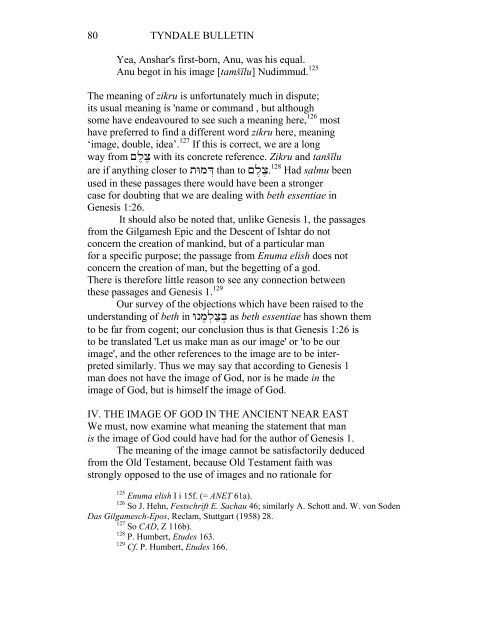THE IMAGE OF GOD IN MAN - Tyndale House
THE IMAGE OF GOD IN MAN - Tyndale House
THE IMAGE OF GOD IN MAN - Tyndale House
- TAGS
- tyndale
- tyndalehouse.com
Create successful ePaper yourself
Turn your PDF publications into a flip-book with our unique Google optimized e-Paper software.
80 TYNDALE BULLET<strong>IN</strong><br />
Yea, Anshar's first-born, Anu, was his equal.<br />
Anu begot in his image [tamšīlu] Nudimmud. 125<br />
The meaning of zikru is unfortunately much in dispute;<br />
its usual meaning is 'name or command , but although<br />
some have endeavoured to see such a meaning here, 126 most<br />
have preferred to find a different word zikru here, meaning<br />
‘image, double, idea’. 127 If this is correct, we are a long<br />
way from םֶלֶצ with its concrete reference. Zikru and tanšīlu<br />
are if anything closer to תּ ומּד ְ than to םֶלֶצ. 128 Had ִsalmu been<br />
used in these passages there would have been a stronger<br />
case for doubting that we are dealing with beth essentiae in<br />
Genesis 1:26.<br />
It should also be noted that, unlike Genesis 1, the passages<br />
from the Gilgamesh Epic and the Descent of Ishtar do not<br />
concern the creation of mankind, but of a particular man<br />
for a specific purpose; the passage from Enuma elish does not<br />
concern the creation of man, but the begetting of a god.<br />
There is therefore little reason to see any connection between<br />
these passages and Genesis 1. 129<br />
Our survey of the objections which have been raised to the<br />
understanding of beth in ּ ונֶמְלַצְּב<br />
as beth essentiae has shown them<br />
to be far from cogent; our conclusion thus is that Genesis 1:26 is<br />
to be translated 'Let us make man as our image' or 'to be our<br />
image', and the other references to the image are to be interpreted<br />
similarly. Thus we may say that according to Genesis 1<br />
man does not have the image of God, nor is he made in the<br />
image of God, but is himself the image of God.<br />
IV. <strong>THE</strong> <strong>IMAGE</strong> <strong>OF</strong> <strong>GOD</strong> <strong>IN</strong> <strong>THE</strong> ANCIENT NEAR EAST<br />
We must, now examine what meaning the statement that man<br />
is the image of God could have had for the author of Genesis 1.<br />
The meaning of the image cannot be satisfactorily deduced<br />
from the Old Testament, because Old Testament faith was<br />
strongly opposed to the use of images and no rationale for<br />
125<br />
Enuma elish I i 15f. (= ANET 61a).<br />
126<br />
So J. Hehn, Festschrift E. Sachau 46; similarly A. Schott and. W. von Soden<br />
Das Gilgamesch-Epos, Reclam, Stuttgart (1958) 28.<br />
127<br />
So CAD, Z 116b).<br />
128<br />
P. Humbert, Etudes 163.<br />
129<br />
Cf. P. Humbert, Etudes 166.

















